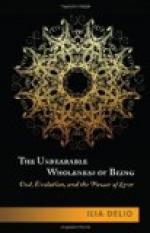The religion of woman and the dominant religion came to terms. This compromise was possible because the Christian pantheon included a female deity who, although she had not hitherto played a prominent part, held an exceptional position: this was Mary, the Mother of the Redeemer. From A.D. 400 to A.D. 1200, her rank had been on a level with the rank of the antique goddesses; now the new emotion enveloped and revivified her. The rigid, soulless image with the golden circle round the head slowly melted into sweet womanhood. In Italy this sentiment inspired wonderful paintings of the Madonna, and was responsible for the development of portraiture in general. The hold of the overwhelming tradition was broken. Rejecting the universal conviction that the historical Mary had resembled the Mary of Byzantine art, the artist, under the dominion of his woman-worship—which surpassed and re-valued all things—drew his inspiration from the fulness of life. I do not agree with Thode that we are indebted to the legend of St. Francis for the modern soulful and highly individualised art. Its source must have been the strongest feeling of the most cultured minds, and that was undoubtedly spiritual love. The Jesuit Beissel wrote with deep regret: “Every master almost formed his own conception of Mary, but in such a way that the hieratic severity of earlier times disappeared but slowly.” And he continued: “It is true, the artists’ models were the noble ladies of their period; not only on account of their kindly smiling faces, but also on account of the charming coquetry with which their hands drew their cloaks across the bosom.” And the art-historian, Male, says: “It is a remarkable fact that in the thirteenth century the legend, or the story, of the Virgin Mary was depicted on the doors of all our (i.e., French) cathedrals.”
The difference between the Catholic and the Protestant world-principles is strongly marked in this connection. Catholicism with its striving for absolute uniformity, acknowledging no individual differences, but eager to shape all life and all doctrines in harmony with one definite ideal, very consistently pronounced one single, historical woman to be divine, and made her the object of universal worship. This dogma had to be rigid, immutable, and almost meaningless. Again, the historic and pagan principle of Catholicism




